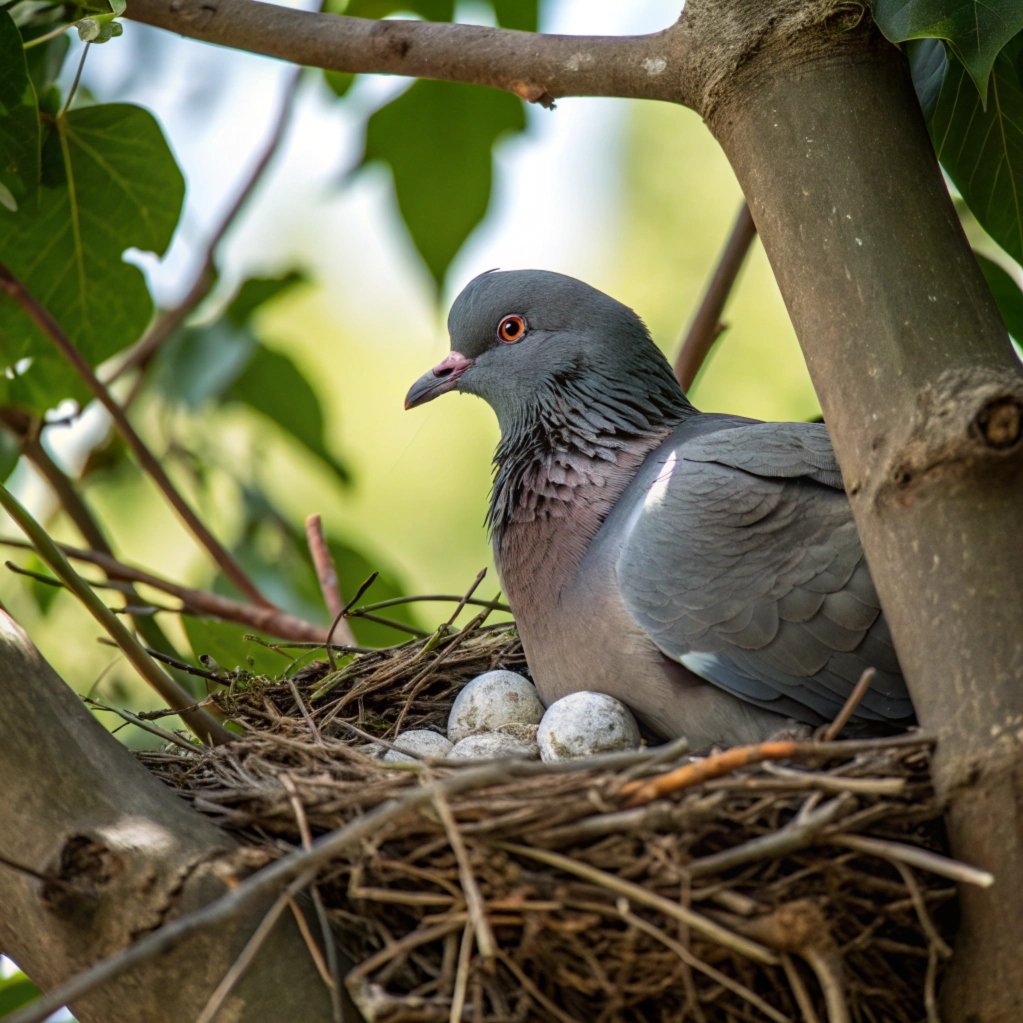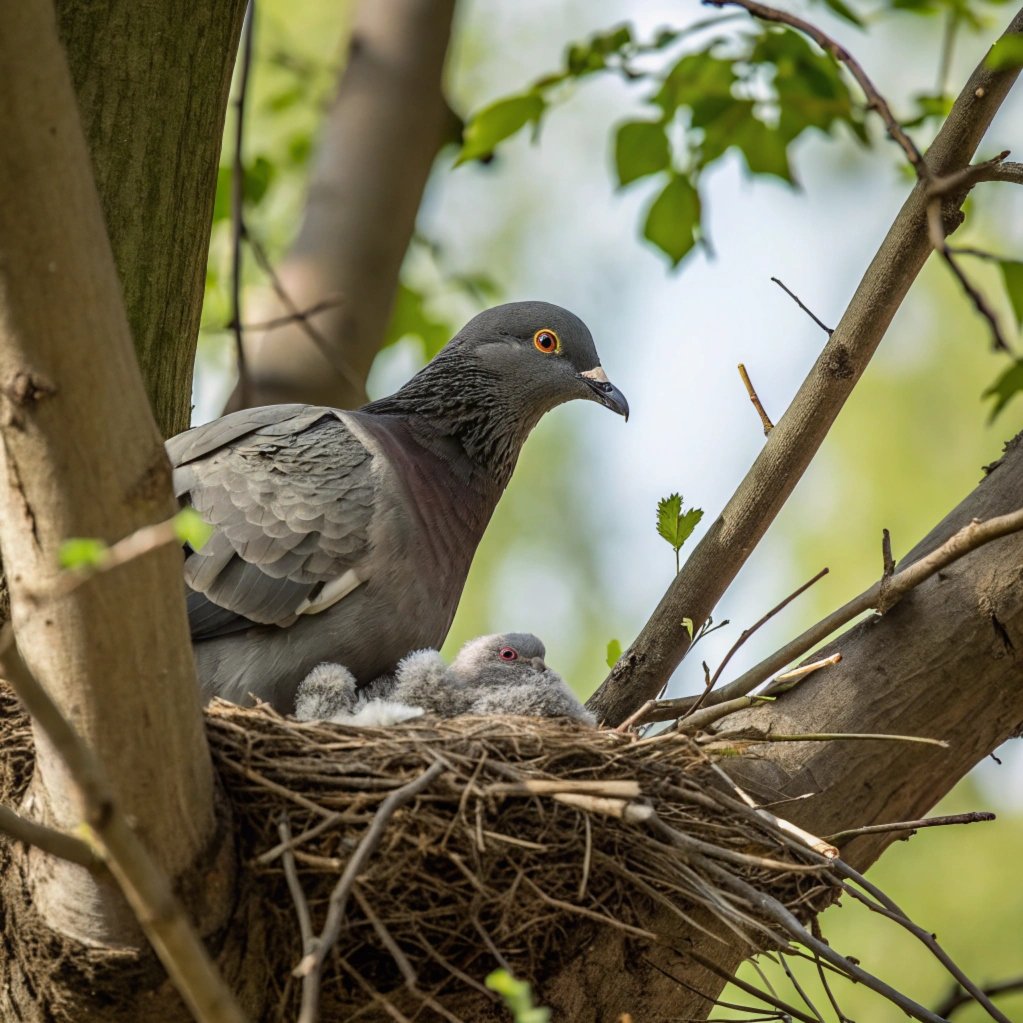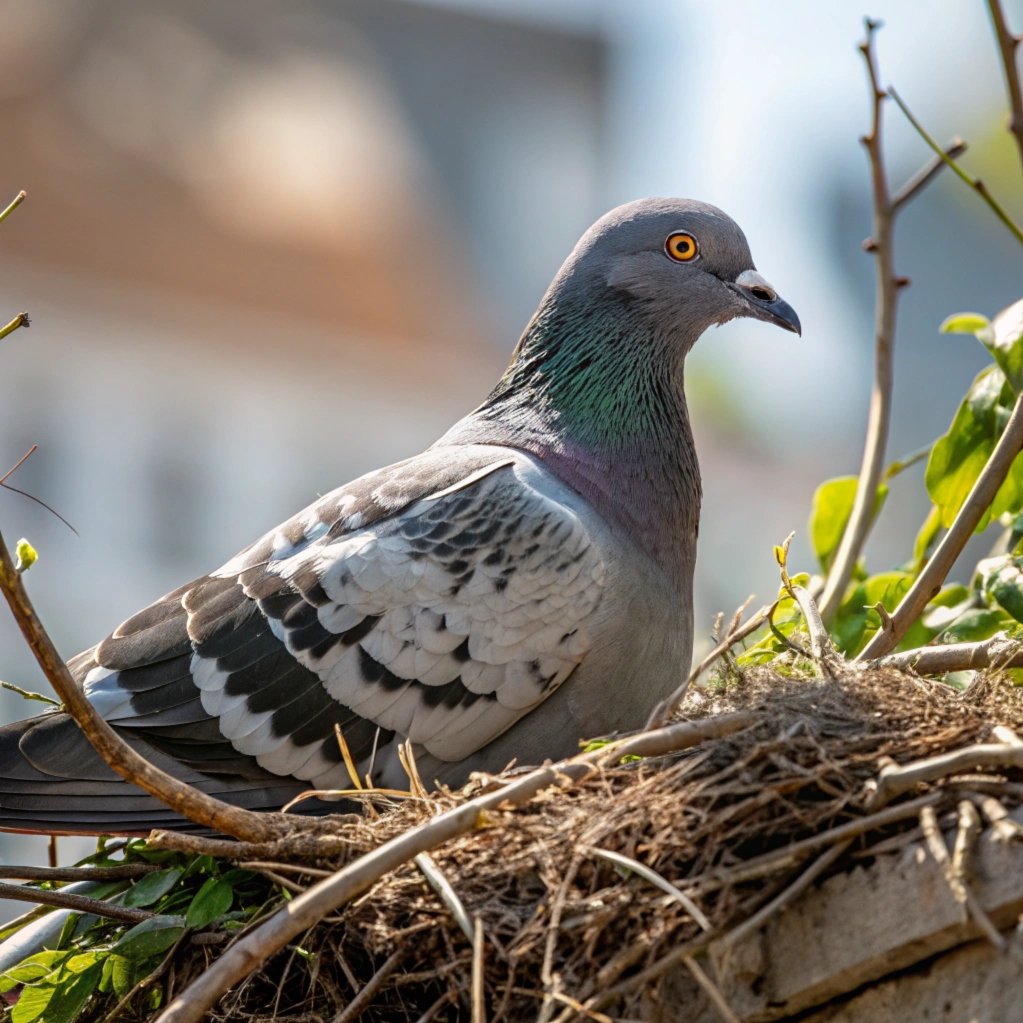Pigeon Nests – A Comprehensive Guide to Urban Bird Nesting Behavior
Pigeons, ubiquitous in urban environments, have adapted remarkably well to human-made structures.
Their nesting habits, while simple, are a testament to their resilience and ability to thrive in diverse settings.
This comprehensive guide delves into the intricacies of pigeon nests, exploring their structure, the birds’ nesting habits, and effective management strategies for urban dwellers and property owners.

Key Takeaways:
- Pigeon nests are simple structures made of twigs, straw, and leaves
- Pigeons prefer sheltered, elevated locations for nesting
- Nests become sturdier over time due to accumulated droppings
- Pigeons can breed year-round, with peak activity in spring and summer
- A pair of pigeons can raise up to five broods annually
- Both male and female pigeons contribute to nest building and care
- Pigeon nests play a crucial role in squab development
- Nests can become health hazards if left unmanaged
- Effective deterrents include physical barriers and professional services
- Regular maintenance and cleaning are essential for pigeon control
The Basics of Pigeon Nesting Behavior
Pigeons, known for their adaptability, have mastered the art of urban living. These birds, descendants of the wild Rock Dove, have found numerous niches in our cities and towns.
Their nesting behavior is a fascinating aspect of their urban adaptation. Pigeons typically begin breeding when they are about six months old and can nest throughout the year, with peak activity during spring and summer.
The breeding season may slow down in autumn and winter, especially in colder climates. Pigeons are monogamous, forming strong pair bonds that often last for life.
This loyalty extends to their nesting sites, which they tend to reuse year after year. The male pigeon usually selects the nesting location, using his cooing calls to attract a mate.
Once paired, both birds contribute to nest building and maintenance, showcasing a cooperative approach to raising their young.
Preferred Nesting Locations for Pigeons
Pigeons have shown remarkable flexibility in choosing their nesting sites, adapting to various urban and rural environments.
In their natural habitat, Rock Doves nest on coastal cliffs and mountainsides. However, their feral descendants have found numerous alternatives in human-made structures.
Pigeons prefer locations that offer shelter from the elements and protection from predators.
Common nesting sites include building ledges, window sills, balconies, bridges, and even abandoned rooms.
They also favor spots under eaves, in attics, and on top of air conditioning units.
The ideal nesting location for pigeons is not only sheltered but also close to reliable food and water sources.
This proximity to resources is crucial for the survival of both adults and their young. Pigeons are known to nest in groups, creating small colonies in suitable areas.
This social nesting behavior can lead to significant accumulations of nests in favorable locations.
The nesting behavior of urban pigeons is deeply rooted in their evolutionary history. These birds, descended from the Rock Dove (Columba livia), have adapted their nesting habits to suit the urban landscape.
The Structure and Composition of Pigeon Nests

Pigeon nests are relatively simple structures, reflecting the birds‘ adaptability and resourcefulness.
Unlike the intricate nests of some bird species, pigeon nests are basic platforms made from readily available materials.
The typical pigeon nest consists of twigs, straw, leaves, and other plant matter gathered from the surrounding environment.
The male pigeon usually collects these materials, bringing them one at a time to the female, who arranges them into a loose, saucer-like structure.
The nest’s simplicity belies its effectiveness in providing a safe space for eggs and hatchlings.
Over time, pigeon nests become more substantial due to an unusual characteristic: pigeons don’t remove waste from their nests.
Instead, their droppings accumulate, mixing with nesting materials to create a sturdier structure.
This habit, while unsightly and potentially hazardous, contributes to the nest’s stability and reusability.
In their natural habitat, Rock Doves nest on coastal cliffs and in rocky crevices, behaviors that translate well to the vertical surfaces and sheltered spots found in cities.
The Nesting Cycle: From Eggs to Fledglings
The pigeon nesting cycle is a well-orchestrated process that ensures the survival of their offspring. Once the nest is built, the female typically lays one or two eggs.
Both parents share incubation duties, with the male usually taking the day shift and the female covering nights and early mornings. This incubation period lasts about 18 days.
After hatching, the young pigeons, called squabs, remain in the nest for four to six weeks. During this time, they are completely dependent on their parents for food and warmth.
Pigeons feed their young with a unique substance called “pigeon milk”, a nutrient-rich secretion produced in their crops.
This high-protein diet allows squabs to grow rapidly, often becoming heavier than their parents before fledging.
The fledging process is gradual, with young pigeons making short flights and returning to the nest before finally leaving.
Interestingly, pigeons often lay a new clutch of eggs before the first brood has fully fledged, leading to overlapping broods.
This evolutionary background explains why pigeons are so adept at nesting on building ledges, window sills, and other man-made structures.
The Impact of Pigeon Nests on Urban Environments

While pigeons have successfully adapted to urban life, their nesting habits can pose challenges for city dwellers and property owners.
The accumulation of pigeon nests on buildings and structures can lead to several issues.
Firstly, the build-up of droppings associated with nests can cause aesthetic problems and potential health hazards.
Pigeon droppings are acidic and can damage building materials over time. Additionally, nests can block drainage systems and ventilation ducts, leading to structural damage.
The presence of pigeon nests also attracts parasites and other pests, which can infest buildings.
From a public health perspective, pigeon nests can harbor diseases transmissible to humans, such as histoplasmosis and cryptococcosis.
The noise from nesting pigeons, particularly during breeding season, can be a nuisance for residents.
Moreover, the sight of numerous nests can negatively impact property values. These factors make pigeon nest management a significant concern in urban areas.
The simplicity of pigeon nests is also a remnant of their ancestral habits, where a basic platform sufficed for raising young in rocky environments.
Over time, pigeons have shown remarkable flexibility in their choice of nesting materials, adapting to use whatever is available in their urban surroundings.
Health and Safety Concerns Related to Pigeon Nests
The presence of pigeon nests in urban areas raises several health and safety concerns that should not be overlooked. Pigeon droppings, which accumulate in and around nests, can harbor various pathogens and parasites.
These include bacteria, fungi, and viruses that can cause diseases in humans. Histoplasmosis, a respiratory disease caused by inhaling spores from fungi growing in pigeon droppings, is a particular concern.
Another health risk is cryptococcosis, a fungal disease that can affect the lungs and nervous system. Pigeon nests also attract mites, ticks, and fleas, which can infest buildings and potentially transmit diseases to humans and pets.
The accumulation of nesting materials and droppings can create slip hazards on walkways and fire hazards in enclosed spaces.
Additionally, large numbers of nests on a building can add significant weight, potentially compromising structural integrity.
For these reasons, it’s crucial to address pigeon nesting issues promptly and effectively to maintain a safe and healthy urban environment.
This adaptability has been key to their success in human-dominated environments.
The tendency of pigeons to nest in colonies is another behavior carried over from their wild ancestors, who found safety in numbers on cliff faces.
Legal and Ethical Considerations in Pigeon Nest Management
Managing pigeon nests in urban areas involves navigating a complex landscape of legal and ethical considerations. In many jurisdictions, pigeons are not protected by wildlife laws, allowing for more flexibility in control measures.
However, it’s crucial to approach nest removal and pigeon control with humane methods.
Many countries and local authorities have regulations against cruel treatment of animals, including pigeons.
This means that lethal control methods are often restricted or prohibited. When dealing with nests, it’s important to consider the presence of eggs or young birds.
In some areas, it may be illegal to disturb active nests containing eggs or nestlings. Ethical considerations also come into play, as many people view pigeons as part of the urban ecosystem and object to harsh control measures.
Property owners and managers must balance the need for pigeon control with animal welfare concerns.
It’s advisable to consult local wildlife authorities or pest control professionals to ensure compliance with relevant laws and regulations when implementing pigeon nest management strategies.
Understanding this evolutionary context helps explain why pigeons are so successful and persistent in their urban nesting habits, and why traditional deterrent methods often have limited long-term success.
Effective Deterrents and Prevention Methods
Preventing pigeon nesting is often more effective and humane than dealing with established nests. Several deterrent methods can discourage pigeons from nesting on buildings and structures.
Physical barriers are among the most effective solutions. bird netting can be installed to block access to potential nesting sites, while bird spikes can prevent pigeons from landing on ledges and rooftops.
Another option is the use of sloped surfaces or bird slides, which make it difficult for pigeons to perch or nest.
Electronic deterrents, such as sound devices that emit predator calls or ultrasonic frequencies, can also be effective, though their long-term success may vary.
Visual deterrents like reflective tape or predator decoys can provide short-term relief but may lose effectiveness over time as pigeons become accustomed to them.
Some property owners opt for chemical repellents, but these should be used cautiously and in compliance with local regulations.
Regular building maintenance, such as sealing potential entry points and removing food sources, can significantly reduce the attractiveness of a site to nesting pigeons.
Professional Pigeon Control Services
When pigeon nesting becomes a significant problem, professional pest control services can offer comprehensive solutions. These experts have the knowledge, experience, and tools to address pigeon infestations effectively and humanely.
Professional services typically begin with a thorough site assessment to identify nesting areas, entry points, and factors attracting pigeons.
Based on this assessment, they develop a customized control plan. This may include a combination of deterrent methods, such as installing physical barriers, applying repellents, or using more advanced technologies like bird control lasers.
Professional services can also safely remove existing nests and clean affected areas, which is crucial for health and safety.
Many companies offer ongoing maintenance programs to prevent future nesting. Importantly, professional pest control operators are familiar with local regulations and can ensure that all control measures are legal and ethical.
While professional services may seem costly, they can be more cost-effective in the long run by providing comprehensive and lasting solutions to pigeon nesting problems.
The Role of Urban Planning in Pigeon Management
Urban planning plays a crucial role in managing pigeon populations and their nesting habits in cities.
By considering the needs and behaviors of urban wildlife, including pigeons, planners can design spaces that discourage problematic nesting while maintaining ecological balance.
One effective strategy is the concept of “pigeon-proofing” new buildings and renovations. This involves incorporating design elements that naturally deter pigeons from nesting, such as sloped ledges or surfaces that are difficult for pigeons to perch on.
Urban planners can also work to reduce food sources that attract pigeons, such as improving waste management systems and educating the public about the impacts of feeding pigeons.
Creating designated areas for pigeons away from residential and commercial zones can help manage their populations more effectively.
Additionally, incorporating green spaces and natural predator habitats into urban designs can help regulate pigeon populations naturally.
By addressing pigeon management at the planning stage, cities can create more harmonious environments for both humans and urban wildlife.
Cleaning and Maintenance After Nest Removal
Once pigeon nests have been removed, thorough cleaning and maintenance are essential to prevent future nesting and address any damage caused by the birds.
The first step is to thoroughly clean the affected area, removing all traces of nesting materials, droppings, and debris.
This process should be done carefully, using appropriate protective equipment, as pigeon droppings can harbor harmful pathogens.
Pressure washing may be necessary for exterior surfaces, while interior spaces might require more delicate cleaning methods.
After cleaning, it’s important to disinfect the area to eliminate any remaining bacteria or parasites. Any damage caused by the nests, such as blocked gutters or vents, should be repaired promptly.
To prevent future nesting, consider applying bird-proofing measures to the cleaned areas. This might include installing physical barriers or applying safe, long-lasting repellents.
Regular inspections and maintenance can help catch and address any new nesting attempts early. Establishing a routine cleaning schedule for areas prone to pigeon activity can also help deter future nesting and maintain the cleanliness and safety of the property.
The Ecological Role of Pigeons in Urban Environments
While often considered a nuisance, pigeons play a significant ecological role in urban environments. These birds have become an integral part of city ecosystems, adapting to human-made habitats in ways that few other species have.
Pigeons serve as a food source for urban predators such as peregrine falcons, which have made a comeback in many cities partly due to the abundance of pigeons.
They also contribute to urban biodiversity, supporting populations of insects and other small organisms that live on or around them.
Pigeons can act as seed dispersers, helping to spread plant species throughout urban areas. Their droppings, while problematic in large quantities, can fertilize urban soils and support plant growth in small doses.
From a broader perspective, pigeons offer city dwellers a connection to wildlife, serving as one of the most visible and accessible forms of urban fauna.
This connection can foster greater awareness and appreciation for urban ecology among city residents.
Understanding the ecological role of pigeons can help inform more balanced and sustainable approaches to managing their populations in urban settings.
FAQs
How often do pigeons lay eggs?
Pigeons can lay eggs year-round, with peak breeding occurring in spring and summer. A single pair can produce up to five broods annually, typically laying two eggs per clutch.
Is it legal to remove pigeon nests?
The legality of removing pigeon nests varies by location. In many areas, it’s legal to remove nests that don’t contain eggs or young birds. However, it’s always best to check local regulations and consider humane removal methods.
How long do pigeon nests last?
Pigeon nests can last for several years if undisturbed. Pigeons often reuse and build upon existing nests, which can grow quite large over time due to accumulated droppings and nesting materials.
Can pigeon nests cause damage to buildings?
Yes, pigeon nests can cause significant damage to buildings. The accumulation of droppings can corrode building materials, while nests can block gutters and vents, leading to water damage and other structural issues.
How can I prevent pigeons from nesting on my property?
Effective prevention methods include installing physical barriers like bird spikes or netting, using visual or auditory deterrents, and removing potential food sources. Regular cleaning and maintenance of potential nesting sites can also discourage pigeons.
Are there any benefits to having pigeons nest in urban areas?
While often considered a nuisance, pigeons do play a role in urban ecosystems. They serve as a food source for predators like falcons and can contribute to urban biodiversity. However, these benefits need to be balanced against the potential problems they can cause.

Hello, I’m Emily Price, the founder of Birds Affection. As a passionate bird enthusiast and spiritual seeker, I’ve always been fascinated by the symbolic meanings and mystical connections between birds and our lives. On this website, I share my knowledge and insights on the spiritual significance of various bird species, exploring their roles as messengers, guides, and teachers. Through my writing, I aim to inspire and educate others on the profound wisdom and beauty that birds bring to our world. Join me on this journey as we delve into the enchanting realm of bird symbolism and discover the hidden meanings behind these magnificent creatures.







